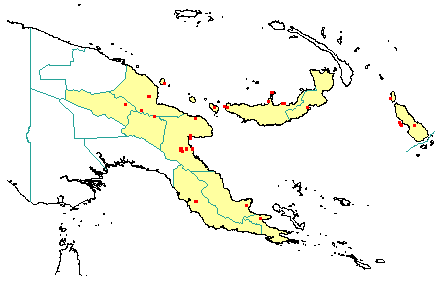
in PNGplants database
PNGTreesKey – Harpullia arborea (Blanco) Radlk. |
Barry Conn (NSW) & Kipiro Damas (LAE).
Guide to trees of Papua New Guinea
Copyright held by the authors, National Herbarium of New South Wales, and Papua New Guinea National Herbarium
Sitzungsberichte der mathematisch-physikalischen Classe der k. b. Akademie der Wissenschaften zu München 16 (1887)
Other Literature: P.W.Leenhouts & M.Vente, Flora Malesiana, Series 1 601-603 (1994) Fig. 45.
Family: Sapindaceae
Dicotyledon
Timber Group: Occasional timber species
Field Characters: Large canopy tree (up to 33 m high, sometimes to 40 m); Bole cylindrical (60-70 cm diam.); straight (bole up to 30 m long); buttresses buttresses present (slightly buttresses up to 3 m long); spines spines absent; aerial roots aerial roots absent; stilt roots stilt roots absent; Bark grey, rough, pustular, lenticels irregular; Subrhytidome (under-bark) green; less than 25 mm thick, 15.0; bark blaze consisting of one layer; strongly aromatic; unpleasant; outer blaze yellowish white or pale brown, markings absent, fibrous; inner blaze yellowish white or pale brown, markings absent, fibrous; bark exudate (sap) absent; terminal buds not enclosed by leaves.
Indumentum: Complex hairs present or absent, star-like (stellate) (actually simple hairs forming stellate-like clusters); stinging hairs absent; mature twig indumentum (hairs) present, hairs sparse.
Leaves: Leaves spaced along branches, spiral (leaves occurring singly at a node and arranged spirally up the branchlet), compound (a leaf made up from two or more leaflets); petiole present, not winged, attached to base of leaf blade, not swollen; leaves rarely with two leaflets or pinnate (unbranched with more than three leaflets) (with up to 6 leaflets); petiolule not swollen; rachis present, absent, absent; leaves without a terminal leaflet (the number of leaflets even - paripinnate), broadest above middle or broadest at or near middle, 8.0-20.0 cm, 5.0-8.0 cm, leaflets alternate, symmetric; venation pinnate, secondary veins open, prominent, intramarginal veins absent; leaves lower surface pale green (glossy), upper surface pale green (glossy), indumentum (hairs) absent or present (on rachis and petiole), indumentum (hairs) sparse; absent; domatia absent; stipules absent.
Flowers: Inflorescence axillary, flowers on an unbranched axis or rarely flowers on a branched axis, cones absent; flowers unisexual, unisexual with male and female flowers on the same plant, stalked, flowers with one plane of symmetry, 15.0 mm long, diameter large (more than10 mm diam.) (15 mm diam.); perianth present, with distinct sepals and petals whorls, inner perianth pink or green (pale faintly); 5, free; stamens 5 (of male flower, with anthers dull pale green to pale maroon), present (dull pale green), free of each other, free of the perianth; ovary superior (of female flower), carpels joined (when more than one), locules 2 (-4); styles free (pale brown to pinkish or very pale green), 100.
Fruits: Infrutescence arranged on unbranched axis, fruit 9.0-31.0 (-40.0) mm long, 20.0 (c.) mm diam., red, not spiny, fleshy, simple, dehiscent, capsule; seeds 1-2, about 10 mm long, not winged, broad (as wide as long), seed 1-10 mm diam. (8-10 mm diam.).
Distribution: Madang, Morobe, Western Highlands, Eastern Highlands, Central, Northern, Milne Bay, New Britain & Bougainville.
 | Botanical records in PNGplants database |